电气类外文翻译---电力电子系统的电磁兼容问题
- 格式:docx
- 大小:24.97 KB
- 文档页数:7
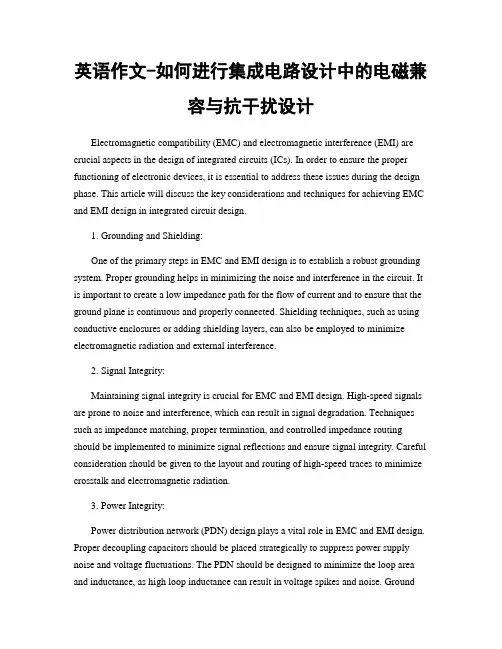
英语作文-如何进行集成电路设计中的电磁兼容与抗干扰设计Electromagnetic compatibility (EMC) and electromagnetic interference (EMI) are crucial aspects in the design of integrated circuits (ICs). In order to ensure the proper functioning of electronic devices, it is essential to address these issues during the design phase. This article will discuss the key considerations and techniques for achieving EMC and EMI design in integrated circuit design.1. Grounding and Shielding:One of the primary steps in EMC and EMI design is to establish a robust grounding system. Proper grounding helps in minimizing the noise and interference in the circuit. It is important to create a low impedance path for the flow of current and to ensure that the ground plane is continuous and properly connected. Shielding techniques, such as using conductive enclosures or adding shielding layers, can also be employed to minimize electromagnetic radiation and external interference.2. Signal Integrity:Maintaining signal integrity is crucial for EMC and EMI design. High-speed signals are prone to noise and interference, which can result in signal degradation. Techniques such as impedance matching, proper termination, and controlled impedance routing should be implemented to minimize signal reflections and ensure signal integrity. Careful consideration should be given to the layout and routing of high-speed traces to minimize crosstalk and electromagnetic radiation.3. Power Integrity:Power distribution network (PDN) design plays a vital role in EMC and EMI design. Proper decoupling capacitors should be placed strategically to suppress power supply noise and voltage fluctuations. The PDN should be designed to minimize the loop area and inductance, as high loop inductance can result in voltage spikes and noise. Groundbounce and power rail collapse should be minimized through careful power distribution network design.4. Filtering and EMI Suppression:The use of appropriate filtering techniques is essential to suppress electromagnetic interference. Passive components such as ferrite beads, capacitors, and inductors can be used to filter out unwanted noise and interference. Differential signaling and common-mode chokes can also be employed to reduce EMI. It is important to analyze the frequency spectrum and identify the specific frequencies to be filtered out.5. ESD Protection:Electrostatic discharge (ESD) can cause significant damage to ICs. Implementing proper ESD protection measures is crucial to ensure the reliability and longevity of integrated circuits. ESD protection devices, such as diodes and transient voltage suppressors, should be incorporated into the design to divert and dissipate electrostatic discharge safely.6. Simulation and Testing:Simulation and testing are essential steps in EMC and EMI design. Various simulation tools can be used to analyze and optimize the design for electromagnetic compatibility. Testing the ICs under different operating conditions and environmental scenarios is necessary to ensure compliance with EMC standards. This includes radiated and conducted emission tests, as well as susceptibility tests.In conclusion, achieving electromagnetic compatibility and mitigating electromagnetic interference in integrated circuit design is crucial for the proper functioning and reliability of electronic devices. By following proper grounding and shielding techniques, ensuring signal and power integrity, implementing effective filtering and ESD protection, and conducting thorough simulation and testing, designers can achieve optimal EMC and EMI design in integrated circuits.。

电磁兼容性在电气工程中的应用引言:电磁兼容性(Electromagnetic Compatibility,简称EMC)是电子与电气工程领域中一个重要的概念。
随着电子设备的普及和电磁辐射的增加,EMC的研究和应用变得愈发重要。
本文将探讨电磁兼容性在电气工程中的应用,包括EMC的定义、原理、测试方法和在电气工程中的实际应用。
定义和原理:EMC是指不同电子设备在同一电磁环境下,能够相互协调地工作,而不会产生互相干扰的能力。
这主要包括两个方面:电磁干扰(Electromagnetic Interference,简称EMI)和电磁耐受性(Electromagnetic Susceptibility,简称EMS)。
EMI是指电子设备在工作时产生的电磁辐射,可能对周围的设备和系统造成干扰。
而EMS是指电子设备在电磁环境中能够正常工作,而不受周围电磁辐射的干扰。
EMC的原理在于控制电磁辐射和提高电磁耐受性。
通过合理的设计和工程措施,可以减少电磁辐射的发生,以及提高电子设备对电磁辐射的抵抗能力。
测试方法:为了保证电子设备的EMC性能,需要进行一系列的测试。
常见的EMC测试方法包括辐射测试和传导测试。
辐射测试主要用于测量电子设备产生的电磁辐射水平。
这种测试通常使用天线和电磁场测量仪器来进行,通过测量电磁辐射的频率、强度和辐射模式,来评估设备的辐射性能。
传导测试主要用于测量电子设备对外界电磁辐射的敏感性。
这种测试通常使用电源线、信号线等传导介质来传递电磁辐射,通过测量设备的工作状态和性能来评估其对外界干扰的抵抗能力。
应用:电磁兼容性在电气工程中有着广泛的应用。
首先,EMC的研究和应用可以帮助设计人员避免电磁干扰对设备的影响,提高设备的可靠性和稳定性。
例如,在电力系统中,EMC的应用可以减少电力设备之间的互相干扰,提高电网的运行效率。
其次,EMC的研究和应用也对电子设备的安全性和可用性有着重要的影响。
通过合理的EMC设计,可以降低电子设备对周围环境和人体的电磁辐射,减少潜在的健康风险。
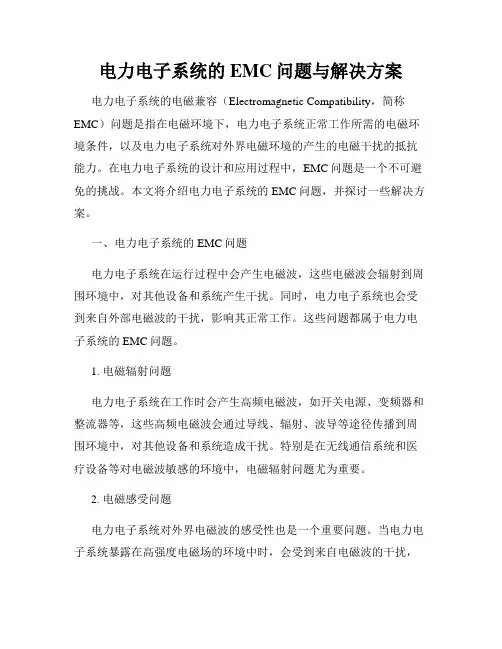
电力电子系统的EMC问题与解决方案电力电子系统的电磁兼容(Electromagnetic Compatibility,简称EMC)问题是指在电磁环境下,电力电子系统正常工作所需的电磁环境条件,以及电力电子系统对外界电磁环境的产生的电磁干扰的抵抗能力。
在电力电子系统的设计和应用过程中,EMC问题是一个不可避免的挑战。
本文将介绍电力电子系统的EMC问题,并探讨一些解决方案。
一、电力电子系统的EMC问题电力电子系统在运行过程中会产生电磁波,这些电磁波会辐射到周围环境中,对其他设备和系统产生干扰。
同时,电力电子系统也会受到来自外部电磁波的干扰,影响其正常工作。
这些问题都属于电力电子系统的EMC问题。
1. 电磁辐射问题电力电子系统在工作时会产生高频电磁波,如开关电源、变频器和整流器等,这些高频电磁波会通过导线、辐射、波导等途径传播到周围环境中,对其他设备和系统造成干扰。
特别是在无线通信系统和医疗设备等对电磁波敏感的环境中,电磁辐射问题尤为重要。
2. 电磁感受问题电力电子系统对外界电磁波的感受性也是一个重要问题。
当电力电子系统暴露在高强度电磁场的环境中时,会受到来自电磁波的干扰,从而影响其正常工作。
例如,在雷电或强磁场环境下,电力电子系统可能会出现故障或损坏。
二、解决电力电子系统的EMC问题的方案为了解决电力电子系统的EMC问题,需要采取一系列的技术手段和措施。
以下是一些常见的解决方案:1. 地线设计地线是电力电子系统中的重要部分,它能够消除电磁干扰并提高系统的EMC性能。
在地线设计中,需要合理布置和连接地线,建立良好的接地系统,使系统的电磁能量得到合理的分配和消耗,从而减少电磁辐射和提高抗干扰能力。
2. 滤波器设计在电力电子系统中安装滤波器可以有效地减少电磁辐射和抑制电磁干扰。
滤波器能够在电源和负载之间形成一个衰减效应,阻止高频电磁波的传播,从而减少对其他设备的干扰。
3. 接地设计良好的接地设计能够有效地降低电磁辐射和提高系统的抗干扰能力。

电器设备的电磁兼容性分析电磁兼容性(Electromagnetic Compatibility,简称EMC)是电子与电气工程中的一个重要概念,它涉及到电器设备在电磁环境中的正常运行和相互干扰问题。
在现代社会中,电子设备的广泛应用使得电磁兼容性成为了一个不可忽视的问题。
本文将探讨电器设备的电磁兼容性分析方法和相关技术。
一、电磁兼容性的概念和重要性电磁兼容性是指电子设备在电磁环境中不受干扰,同时也不对其他设备造成干扰的能力。
在现代社会中,电子设备的使用越来越广泛,各种设备之间的电磁干扰问题也日益突出。
电磁干扰可能导致设备性能下降、数据传输错误、系统崩溃等问题,甚至对人身安全造成威胁。
因此,保证电器设备的电磁兼容性至关重要。
二、电磁兼容性分析的基本原理电磁兼容性分析主要涉及两个方面:电磁干扰源分析和受干扰设备分析。
电磁干扰源分析是指对电器设备产生的电磁辐射进行评估和分析,以确定其辐射强度和频谱特性。
受干扰设备分析是指对电器设备的抗干扰能力进行评估和分析,以确定其对外界电磁干扰的敏感程度。
在电磁干扰源分析中,常用的方法包括电磁场测量、电磁辐射模型计算和电磁辐射测试等。
通过对电器设备周围的电磁场进行测量,可以获取到电磁辐射源的辐射强度和频谱特性,从而评估其对周围设备的干扰程度。
同时,利用电磁辐射模型进行计算,可以预测电器设备在不同工作状态下的电磁辐射情况。
此外,还可以通过电磁辐射测试来验证模型计算的准确性。
在受干扰设备分析中,常用的方法包括电磁兼容性测试和抗干扰设计等。
电磁兼容性测试通过将受干扰设备暴露在不同的电磁干扰环境下,评估其对外界干扰的敏感程度。
根据测试结果,可以对受干扰设备进行相应的抗干扰设计,提高其电磁兼容性。
三、电磁兼容性分析的应用电磁兼容性分析在电子与电气工程中有着广泛的应用。
首先,在电器设备的设计和制造过程中,电磁兼容性分析可以帮助设计人员评估和改进设备的电磁兼容性,确保设备在投入使用前就具备较好的抗干扰能力。
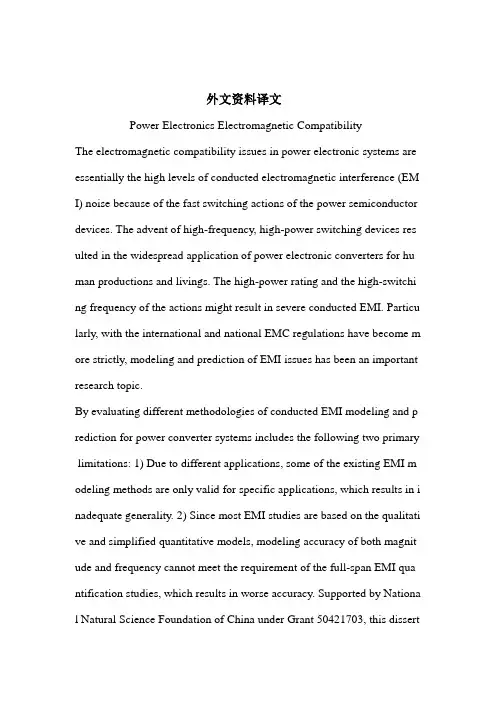
外文资料译文Power Electronics Electromagnetic CompatibilityThe electromagnetic compatibility issues in power electronic systems are essentially the high levels of conducted electromagnetic interference (EM I) noise because of the fast switching actions of the power semiconductor devices. The advent of high-frequency, high-power switching devices res ulted in the widespread application of power electronic converters for hu man productions and livings. The high-power rating and the high-switchi ng frequency of the actions might result in severe conducted EMI. Particu larly, with the international and national EMC regulations have become m ore strictly, modeling and prediction of EMI issues has been an important research topic.By evaluating different methodologies of conducted EMI modeling and p rediction for power converter systems includes the following two primary limitations: 1) Due to different applications, some of the existing EMI m odeling methods are only valid for specific applications, which results in i nadequate generality. 2) Since most EMI studies are based on the qualitati ve and simplified quantitative models, modeling accuracy of both magnit ude and frequency cannot meet the requirement of the full-span EMI qua ntification studies, which results in worse accuracy. Supported by Nationa l Natural Science Foundation of China under Grant 50421703, this dissertation aims to achieve an accurate prediction and a general methodology. S everal works including the EMI mechanisms and the EMI quantification c omputations are developed for power electronic systems. The main conte nts and originalities in this research can be summarized as follows.I. Investigations on General Circuit Models and EMI Coupling Modes In order to efficiently analyze and design EMI filter, the conducted EMI n oise is traditional decoupled to common-mode (CM) and differential-mod e (DM) components. This decoupling is based on the assumption that EM I propagation paths have perfectly balanced and time-invariant circuit stru ctures. In a practical case, power converters usually present inevitable uns ymmetrical or time-variant characteristics due to the existence of semicon ductor switches. So DM and CM components can not be totally decouple d and they can transform to each other. Therefore, the mode transformatio n led to another new mode of EMI: mixed-mode EMI. In order to underst and fundamental mechanisms by which the mixed-mode EMI noise is exc ited and coupled, this dissertation proposes the general concept of lumped circuit model for representing the EMI noise mechanism for power electr onic converters. The effects of unbalanced noise source impedances on E MI mode transformation are analyzed. The mode transformations betwee n CM and DM components are modeled. The fundamental mechanism of the on-intrinsic EMI is first investigated for a switched mode power suppl y converter. In discontinuousconduction mode, the DM noise is highly dependent on CM noise becaus e of the unbalanced diode-bridge conduction. It is shown that with the sui table and justified model, many practical filters pertinent to mixed-mode EMI are investigated, and the noise attenuation can also be derived theore tically. These investigations can provide a guideline for full understandin g of the EMI mechanism and accuracy modeling in power electronic conv erters. (Publications: A new technique for modeling and analysis of mixed -mode conducted EMI noise, IEEE Transactions on Power Electronics, 20 04; Study of differential-mode EMI of switching power supplies with rec tifier front-end, Transactions of China Electrotechnical Society, 2006) II. Identification of Essential Coupling Path Models for Conducted EMI P redictionConducted EMI prediction problem is essentially the problem of EMI noi se source modeling and EMI noise propagation path modeling. These mo deling methods can be classified into two approaches, mathematics-based method and measurement-based method. The mathematics method is ver y time-consuming because the circuit models are very complicated. The measurement method is only valid for specific circuit that is conveniently to be measured, and is lack of generality and impracticability. This disser tation proposes a novel modeling concept, called essential coupling path models, derived from a circuit theoretical viewpoint, means that the simplest models contain the dominant noise sources and the dominant noise co upling paths, which can provide a full feature of the EMI generations. Ap plying the new idea, this work investigates the conducted EMI coupling i n an AC/DC half-bridge converter. Three modes of conducted EMI noise are identified by time domain measurements. The lumped circuit models are derived to describe the essential coupling paths based on the identifica tion of the EMI coupling modes. Meanwhile, this study illustrates the extr action of the parameters in the afore-described models by measurements, and demonstrates the significance of each coupling path in producing con ducted EMI. It is shown that the proposed method is very effective and ac curate in identifying and capturing EMI features. The equivalent models of EMI noise are sorted out by just a few simple measurements. Under th ese approaches, EMI performance can be predicted together with the filte ring strategies. (Publications: Identification of essential coupling path mo dels for conducted EMI prediction in switching power converters, IEEE T ransactions on Power Electronics, 2006; Noise source lumped circuit mo deling and identification for power converters, IEEE Transactions on Indu strial Electronics, 2006)III. High Frequency Conducted EMI Source ModelingThe conventional method of EMI prediction is to model the current or vol tage source as a periodic trapezoidal pulse train. However, the single slop e approximation for rise and fall transitions can not characterize the real switching transitions involved in high frequency resonances. In most com mon noise source models simple trapezoidal waveforms are used where t he high frequency information of the EMI spectrum is lost. Those models made several important assumptions which greatly impair accuracy in th e high frequency range of conducted noise. To achieve reasonable accurac y for EMI modeling at higher frequencies, the relationship between the s witching transitions modeling and the EMI spectrum is studied. An impor tant criterion is deduced to give the reasonable modeling frequency range for the traditional simple approximation method. For the first time, an im proved and simplified EMI source modeling method based on multiple sl ope approximation of device switching transitions is presented. To confir m the proposed method, a buck circuit prototype using an IGBT module i s implemented. Compared with the superimposed envelops of the measur ed spectra, it can be seen that the effective modeling frequency is extende d to more than 10 MHz, which verifies that the proposed multiple slopes s witching waveform approximation method can be applied for full-span E MI noise quantification studies. (Publications: Multiple slope switching w aveform approximation to improve conducted EMI spectral analysis of po wer converters, IEEE Transactions on Electromagnetic Compatibility, 20 06; Power converter EMI analysis including IGBT nonlinear switching tr ansient model, IEEE Transactions on Industrial Electronics, 2006)IV. Loop Coupling EMI Modeling in Power Electronic Systems Practical examples of power electronic systems that have various electric al, electromechanical and electronics apparatus emit electromagnetic ener gy in the course of their normal operations. In order to predict the EMI no ise in a system level, it is significant to model the EMI propagation chara cteristics through electromagnetic coupling between two apparatus circuit within a power electronic system. The PEEC modeling technique which was first introduced in 1970s has recently becomes a popular choice in rel ation to the electromagnetic analysis and EMI coupling. In previous studi es, the integral equation based method was mostly applied in the electrica l modeling and analysis of the interconnect structure in very large scale in tegration systems, only at the electronic chip and package level. By introd ucing the partial inductance theory of PEEC modeling technique, this wor k investigates the EMI loop coupling issues in power electronic circuits. The work models the magnetic flux coupling due to EMI current on one c onductor and another by mutual inductance. To model the EMI coupling between the grounding circuits, this study divides the ground impedance i nto two parts: one is the internal impedance and the other is the external i nductance. The external inductance due to the fields external to the rectan gular grounding loop and flat conductor is modeled. To verify the mathe matical models, the steel plane grounding test configurations are constructed and the DM and CM EMI coupling generation and modeling techniqu e are experimentally studied. The comparison between the measured and calculated EMI noise voltage validates the proposed analysis and models. These investigations and results can provide a powerful engineering appl ication of analyzing and solving the coupling EMI issues in power electro nic circuits and systems. (This part of work is one of the main contributio ns of the awarded project of Military Science and Technology Award in 2 006, where the author is No. 4 position. Publication: Loop coupled EMI a nalysis based on partial inductance models, Proceedings of the Chinese S ociety of Electrical Engineering, 2007)V. Conducted EMI Prediction for PWM Conversion UnitsPWM-based power conversion units are the main EMI noise sources in p ower systems. Due to the various PWM strategies and the large number o f switches, a common analytical approach for the PWM-based switched c onverter systems has not been dated. Determination of the frequency spec trum of a PWM converter is quite complex and is often done by using an FFT analysis of a simulated time-varying switched waveform. This appro ach requires considerable computing capacity and always leaves the unce rtainty as to whether a subtle simulation round-off or error may have sligh tly tarnished the results obtained. By introducing the principle of the doub le Fourier integral, this work presents a general method for modeling the conduced EMI sources of PWM conversion units by identifying double integral Fourier form to suit each PWM modulation. Appling the proposed method, three PWM strategies have been discussed. The effects of differe nt modulation schemes on EMI spectrum are evaluated. The EMI modeli ng and prediction efforts from an industrial application system are studied comprehensively. Comparison between the measured and the predicted s pectrum confirms the validity of the EMI modeling and prediction metho d. This method breaks through the limitations of time-consuming and con siderable accumulated error by traditional time-domain simulations. A sta ndard without relying on simulation but a common analytical approach ha s been obtained. Clearly, it can be regarded as a common analytical appro ach that would be useful to be able to model and predict the exact EMI pe rformance of the PWM-based power electronic systems. (Publications: D M and CM EMI Sources Modeling for Inverters Considering the PWM St rategies, Transactions of China Electrotechnical Society, 2007. High Freq uency Model of Conducted EMI for PWM Variable-speed Drive Systems, Proceedings of the Chinese Society of Electrical Engineering, 2008)。
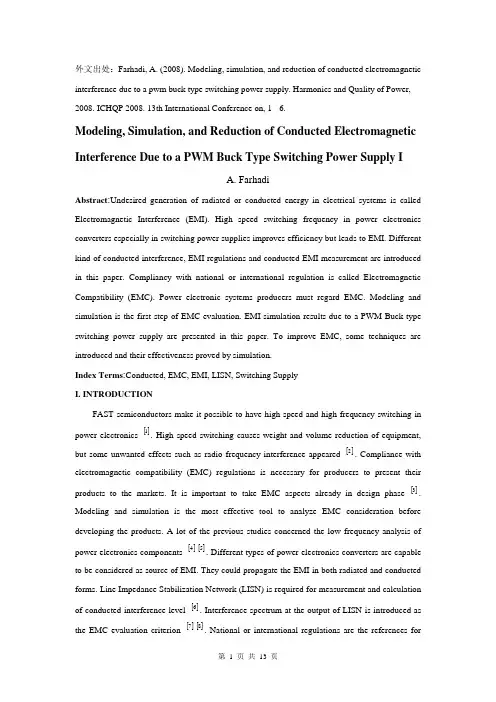
外文出处:Farhadi, A. (2008). Modeling, simulation, and reduction of conducted electromagnetic interference due to a pwm buck type switching power supply. Harmonics and Quality of Power, 2008. ICHQP 2008. 13th International Conference on, 1 - 6.Modeling, Simulation, and Reduction of Conducted Electromagnetic Interference Due to a PWM Buck Type Switching Power Supply IA. FarhadiAbstract:Undesired generation of radiated or conducted energy in electrical systems is called Electromagnetic Interference (EMI). High speed switching frequency in power electronics converters especially in switching power supplies improves efficiency but leads to EMI. Different kind of conducted interference, EMI regulations and conducted EMI measurement are introduced in this paper. Compliancy with national or international regulation is called Electromagnetic Compatibility (EMC). Power electronic systems producers must regard EMC. Modeling and simulation is the first step of EMC evaluation. EMI simulation results due to a PWM Buck type switching power supply are presented in this paper. To improve EMC, some techniques are introduced and their effectiveness proved by simulation.Index Terms:Conducted, EMC, EMI, LISN, Switching SupplyI. INTRODUCTIONFAST semiconductors make it possible to have high speed and high frequency switching in power electronics []1. High speed switching causes weight and volume reduction of equipment, but some unwanted effects such as radio frequency interference appeared []2. Compliance with electromagnetic compatibility (EMC) regulations is necessary for producers to present their products to the markets. It is important to take EMC aspects already in design phase []3. Modeling and simulation is the most effective tool to analyze EMC consideration before developing the products. A lot of the previous studies concerned the low frequency analysis of power electronics components []4[]5. Different types of power electronics converters are capable to be considered as source of EMI. They could propagate the EMI in both radiated and conducted forms. Line Impedance Stabilization Network (LISN) is required for measurement and calculation of conducted interference level []6. Interference spectrum at the output of LISN is introduced as the EMC evaluation criterion []7[]8. National or international regulations are the references forthe evaluation of equipment in point of view of EMC []7[]8.II. SOURCE, PATH AND VICTIM OF EMIUndesired voltage or current is called interference and their cause is called interference source. In this paper a high-speed switching power supply is the source of interference.Interference propagated by radiation in area around of an interference source or by conduction through common cabling or wiring connections. In this study conducted emission is considered only. Equipment such as computers, receivers, amplifiers, industrial controllers, etc that are exposed to interference corruption are called victims. The common connections of elements, source lines and cabling provide paths for conducted noise or interference. Electromagnetic conducted interference has two components as differential mode and common mode []9.A. Differential mode conducted interferenceThis mode is related to the noise that is imposed between different lines of a test circuit by a noise source. Related current path is shown in Fig. 1 []9. The interference source, path impedances, differential mode current and load impedance are also shown in Fig. 1.B. Common mode conducted interferenceCommon mode noise or interference could appear and impose between the lines, cables or connections and common ground. Any leakage current between load and common ground couldbe modeled by interference voltage source.Fig. 2 demonstrates the common mode interference source, common mode currents Iandcm1 and the related current paths[]9.The power electronics converters perform as noise source Icm2between lines of the supply network. In this study differential mode of conducted interference is particularly important and discussion will be continued considering this mode only.III. ELECTROMAGNETIC COMPATIBILITY REGULATIONS Application of electrical equipment especially static power electronic converters in different equipment is increasing more and more. As mentioned before, power electronics converters are considered as an important source of electromagnetic interference and have corrupting effects on the electric networks []2. High level of pollution resulting from various disturbances reduces the quality of power in electric networks. On the other side some residential, commercial and especially medical consumers are so sensitive to power system disturbances including voltage and frequency variations. The best solution to reduce corruption and improve power quality is complying national or international EMC regulations. CISPR, IEC, FCC and VDE are among the most famous organizations from Europe, USA and Germany who are responsible for determining and publishing the most important EMC regulations. IEC and VDE requirement and limitations on conducted emission are shown in Fig. 3 and Fig. 4 []7[]9.For different groups of consumers different classes of regulations could be complied. Class Afor common consumers and class B with more hard limitations for special consumers are separated in Fig. 3 and Fig. 4. Frequency range of limitation is different for IEC and VDE that are 150 kHz up to 30 MHz and 10 kHz up to 30 MHz respectively. Compliance of regulations is evaluated by comparison of measured or calculated conducted interference level in the mentioned frequency range with the stated requirements in regulations. In united European community compliance of regulation is mandatory and products must have certified label to show covering of requirements []8.IV. ELECTROMAGNETIC CONDUCTED INTERFERENCE MEASUREMENTA. Line Impedance Stabilization Network (LISN)1-Providing a low impedance path to transfer power from source to power electronics converter and load.2-Providing a low impedance path from interference source, here power electronics converter, to measurement port.Variation of LISN impedance versus frequency with the mentioned topology is presented inFig. 7. LISN has stabilized impedance in the range of conducted EMI measurement []7.Variation of level of signal at the output of LISN versus frequency is the spectrum of interference. The electromagnetic compatibility of a system can be evaluated by comparison of its interference spectrum with the standard limitations. The level of signal at the output of LISN in frequency range 10 kHz up to 30 MHz or 150 kHz up to 30 MHz is criterion of compatibility and should be under the standard limitations. In practical situations, the LISN output is connected to a spectrum analyzer and interference measurement is carried out. But for modeling and simulation purposes, the LISN output spectrum is calculated using appropriate software.基于压降型PWM开关电源的建模、仿真和减少传导性电磁干扰摘要:电子设备之中杂乱的辐射或者能量叫做电磁干扰(EMI)。
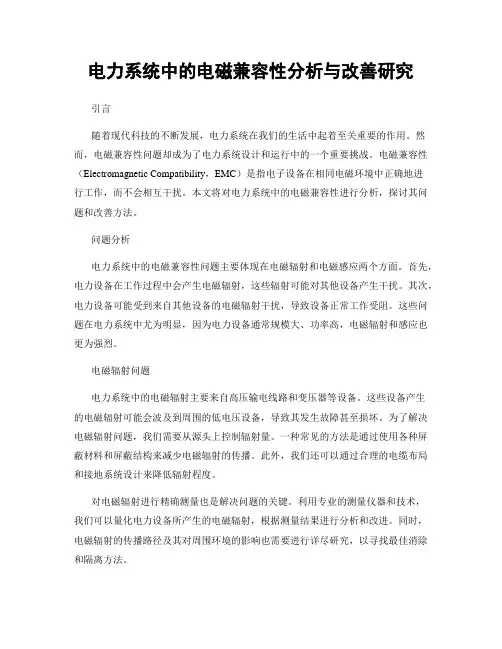
电力系统中的电磁兼容性分析与改善研究引言随着现代科技的不断发展,电力系统在我们的生活中起着至关重要的作用。
然而,电磁兼容性问题却成为了电力系统设计和运行中的一个重要挑战。
电磁兼容性(Electromagnetic Compatibility,EMC)是指电子设备在相同电磁环境中正确地进行工作,而不会相互干扰。
本文将对电力系统中的电磁兼容性进行分析,探讨其问题和改善方法。
问题分析电力系统中的电磁兼容性问题主要体现在电磁辐射和电磁感应两个方面。
首先,电力设备在工作过程中会产生电磁辐射,这些辐射可能对其他设备产生干扰。
其次,电力设备可能受到来自其他设备的电磁辐射干扰,导致设备正常工作受阻。
这些问题在电力系统中尤为明显,因为电力设备通常规模大、功率高,电磁辐射和感应也更为强烈。
电磁辐射问题电力系统中的电磁辐射主要来自高压输电线路和变压器等设备。
这些设备产生的电磁辐射可能会波及到周围的低电压设备,导致其发生故障甚至损坏。
为了解决电磁辐射问题,我们需要从源头上控制辐射量。
一种常见的方法是通过使用各种屏蔽材料和屏蔽结构来减少电磁辐射的传播。
此外,我们还可以通过合理的电缆布局和接地系统设计来降低辐射程度。
对电磁辐射进行精确测量也是解决问题的关键。
利用专业的测量仪器和技术,我们可以量化电力设备所产生的电磁辐射,根据测量结果进行分析和改进。
同时,电磁辐射的传播路径及其对周围环境的影响也需要进行详尽研究,以寻找最佳消除和隔离方法。
电磁感应问题除了电磁辐射外,电力系统中的电磁感应问题同样值得重视。
电力系统中运行的电流和电压变化可能会诱发电磁感应,导致其他设备中出现错误信号和干扰。
为了避免电磁感应问题,我们可以采取以下措施:1. 合理设计电缆布局和线路路径,避免电流和电压变化对其他设备产生感应作用;2. 利用合适的屏蔽和绝缘材料进行保护,减少电磁感应的传播;3. 注意设备之间的隔离和接地问题,避免不必要的电磁耦合;4. 通过使用滤波器和隔离变压器等设备来消除电磁感应带来的干扰。

电动机的电磁兼容与电磁兼容性优化电动机的电磁兼容(Electromagnetic Compatibility,简称EMC)问题一直以来都是制约电力系统稳定运行的重要因素之一。
电动机所产生的电磁干扰不仅会影响到其他电气设备的正常工作,还会对电力系统的整体性能和可靠性造成负面影响。
因此,如何提高电动机的电磁兼容性已成为当前电力系统研究的一个热门领域。
一、电动机电磁兼容性的问题在电动机运行过程中,由于电流的突变和电压的快速变化,会产生较大的电磁干扰。
这些干扰主要包括辐射干扰和传导干扰两种形式。
辐射干扰是指电动机在运行过程中产生的电磁波通过空气传输,对周围电气设备和通讯系统产生干扰。
传导干扰则是指电动机通过电力线、引线等传输路径,将干扰信号传导到其他设备中。
这些电磁干扰会导致其他电气设备的误操作、故障甚至损坏,严重时还会对通讯系统、无线电系统等产生干扰影响。
二、电磁兼容性优化的方法为了提高电动机的电磁兼容性,需要采取一系列的优化措施来降低电磁干扰的产生和传播。
1. 设计优化通过合理的电机设计,可以减少电磁干扰的产生。
在电机结构和线圈布局上,可以采用屏蔽措施来减弱辐射干扰和传导干扰。
同时,合理选择导线直径和绝缘材料等,也可以有效地降低传导干扰的产生。
2. 滤波器应用在电动机的供电线路上安装滤波器可以有效地减少传导干扰。
滤波器可以在特定频段上消除干扰信号,使其不影响其他设备的正常工作。
选择合适的滤波器类型和参数,可以实现对不同频率干扰的屏蔽作用。
3. 接地和屏蔽良好的接地和屏蔽设计也是提高电磁兼容性的关键。
通过良好的接地设计,可以有效降低电磁干扰的浮动电位,减少对其他设备的传导干扰。
同时,在电机的壳体和连接线路上采用屏蔽层,可以有效地防止辐射干扰的发生。
4. 控制策略优化电动机的控制策略也是影响电磁兼容性的一个重要因素。
合理选择控制方法和参数,可以降低电机运行时的电流和电压突变,减少产生干扰的可能性。
此外,采用软启动、软停止等控制策略,也能减少电机在启停过程中产生的较大冲击。
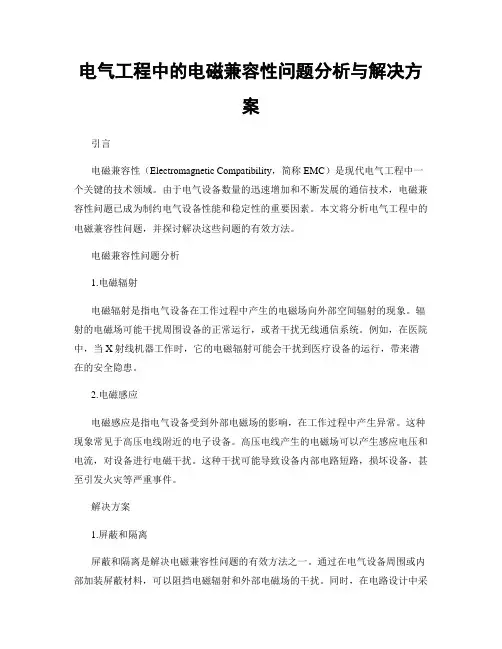
电气工程中的电磁兼容性问题分析与解决方案引言电磁兼容性(Electromagnetic Compatibility,简称EMC)是现代电气工程中一个关键的技术领域。
由于电气设备数量的迅速增加和不断发展的通信技术,电磁兼容性问题已成为制约电气设备性能和稳定性的重要因素。
本文将分析电气工程中的电磁兼容性问题,并探讨解决这些问题的有效方法。
电磁兼容性问题分析1.电磁辐射电磁辐射是指电气设备在工作过程中产生的电磁场向外部空间辐射的现象。
辐射的电磁场可能干扰周围设备的正常运行,或者干扰无线通信系统。
例如,在医院中,当X射线机器工作时,它的电磁辐射可能会干扰到医疗设备的运行,带来潜在的安全隐患。
2.电磁感应电磁感应是指电气设备受到外部电磁场的影响,在工作过程中产生异常。
这种现象常见于高压电线附近的电子设备。
高压电线产生的电磁场可以产生感应电压和电流,对设备进行电磁干扰。
这种干扰可能导致设备内部电路短路,损坏设备,甚至引发火灾等严重事件。
解决方案1.屏蔽和隔离屏蔽和隔离是解决电磁兼容性问题的有效方法之一。
通过在电气设备周围或内部加装屏蔽材料,可以阻挡电磁辐射和外部电磁场的干扰。
同时,在电路设计中采用合理的线路走向和隔离电源,可以降低电磁感应的影响。
例如,对于医疗设备,可以在设备周围加装屏蔽罩,有效防止X射线的干扰。
2.滤波器和抑制措施滤波器是电气设备中常用的抑制电磁干扰的设备。
通过在设备输入和输出电路上安装滤波器,可以降低电磁噪声的传导。
此外,合理设计接地系统和使用电接触件抑制干扰,也可以有效减少电磁干扰。
3.规范和测试制定规范和标准是解决电磁兼容性问题的基础。
通过制定统一的电磁兼容性测试方法和评估指标,可以规范电气设备的设计和生产过程。
同时,定期进行电磁兼容性测试,对设备进行评估和监控,及时发现和解决潜在的电磁兼容性问题。
实例分析为了更好地理解电磁兼容性问题及其解决方案,我们以手机与医疗设备的干扰问题为例进行分析。
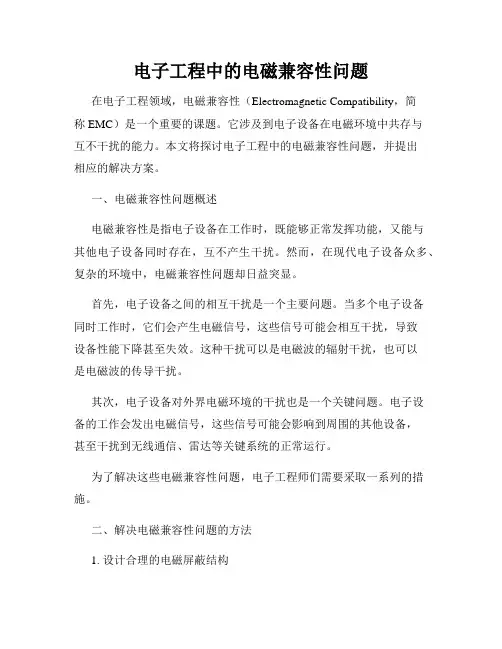
电子工程中的电磁兼容性问题在电子工程领域,电磁兼容性(Electromagnetic Compatibility,简称EMC)是一个重要的课题。
它涉及到电子设备在电磁环境中共存与互不干扰的能力。
本文将探讨电子工程中的电磁兼容性问题,并提出相应的解决方案。
一、电磁兼容性问题概述电磁兼容性是指电子设备在工作时,既能够正常发挥功能,又能与其他电子设备同时存在,互不产生干扰。
然而,在现代电子设备众多、复杂的环境中,电磁兼容性问题却日益突显。
首先,电子设备之间的相互干扰是一个主要问题。
当多个电子设备同时工作时,它们会产生电磁信号,这些信号可能会相互干扰,导致设备性能下降甚至失效。
这种干扰可以是电磁波的辐射干扰,也可以是电磁波的传导干扰。
其次,电子设备对外界电磁环境的干扰也是一个关键问题。
电子设备的工作会发出电磁信号,这些信号可能会影响到周围的其他设备,甚至干扰到无线通信、雷达等关键系统的正常运行。
为了解决这些电磁兼容性问题,电子工程师们需要采取一系列的措施。
二、解决电磁兼容性问题的方法1. 设计合理的电磁屏蔽结构电磁屏蔽是一种常见的解决电磁兼容性问题的方法。
通过合理设计电子设备的外壳结构,可以减少电磁波的辐射干扰和传导干扰。
常见的电磁屏蔽材料有金属、金属涂层、导电聚合物等,它们都能够有效地吸收或反射电磁波,减少干扰。
2. 优化电磁兼容性设计电磁兼容性设计是在电子设备的设计阶段进行的重要环节。
通过合理布局电子元件、引线、电源线等,可以减少信号间的干扰。
此外,还可以采用减少信号传输速率、增加传输距离等措施,降低传导干扰的影响。
3. 加强传导干扰抑制传导干扰是指电磁信号通过导体传导而引起的干扰。
为了减少传导干扰,可以采用屏蔽线、滤波器、隔离放大器等措施。
此外,合理设计地线系统和电源线路,也能有效地降低传导干扰的程度。
4. 控制辐射干扰辐射干扰是指电磁信号通过空间传播而引起的干扰。
为了控制辐射干扰,可以采用屏蔽结构、地线系统、滤波器等手段来限制电磁波的辐射。
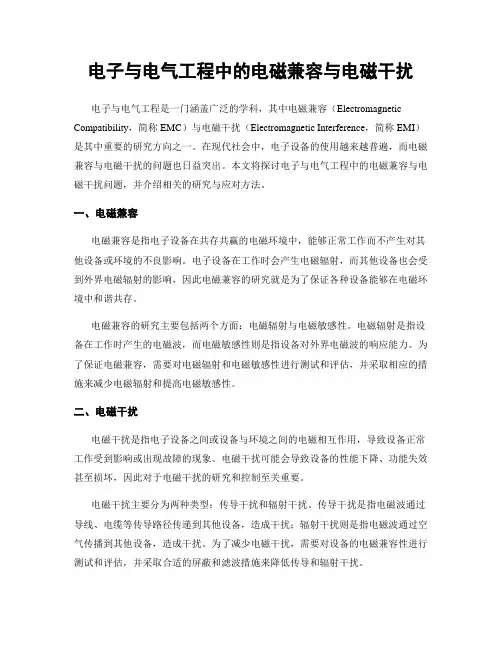
电子与电气工程中的电磁兼容与电磁干扰电子与电气工程是一门涵盖广泛的学科,其中电磁兼容(Electromagnetic Compatibility,简称EMC)与电磁干扰(Electromagnetic Interference,简称EMI)是其中重要的研究方向之一。
在现代社会中,电子设备的使用越来越普遍,而电磁兼容与电磁干扰的问题也日益突出。
本文将探讨电子与电气工程中的电磁兼容与电磁干扰问题,并介绍相关的研究与应对方法。
一、电磁兼容电磁兼容是指电子设备在共存共赢的电磁环境中,能够正常工作而不产生对其他设备或环境的不良影响。
电子设备在工作时会产生电磁辐射,而其他设备也会受到外界电磁辐射的影响,因此电磁兼容的研究就是为了保证各种设备能够在电磁环境中和谐共存。
电磁兼容的研究主要包括两个方面:电磁辐射与电磁敏感性。
电磁辐射是指设备在工作时产生的电磁波,而电磁敏感性则是指设备对外界电磁波的响应能力。
为了保证电磁兼容,需要对电磁辐射和电磁敏感性进行测试和评估,并采取相应的措施来减少电磁辐射和提高电磁敏感性。
二、电磁干扰电磁干扰是指电子设备之间或设备与环境之间的电磁相互作用,导致设备正常工作受到影响或出现故障的现象。
电磁干扰可能会导致设备的性能下降、功能失效甚至损坏,因此对于电磁干扰的研究和控制至关重要。
电磁干扰主要分为两种类型:传导干扰和辐射干扰。
传导干扰是指电磁波通过导线、电缆等传导路径传递到其他设备,造成干扰;辐射干扰则是指电磁波通过空气传播到其他设备,造成干扰。
为了减少电磁干扰,需要对设备的电磁兼容性进行测试和评估,并采取合适的屏蔽和滤波措施来降低传导和辐射干扰。
三、电磁兼容与电磁干扰的研究与应对方法为了解决电磁兼容与电磁干扰问题,研究人员采用了多种方法。
首先,他们通过建立电磁场模型和电路模型来分析和预测电磁辐射和敏感性。
这些模型可以帮助设计人员在设计阶段就考虑到电磁兼容与电磁干扰的问题,并采取相应的措施来优化设计。
电力系统中电磁兼容性问题研究在当今高度依赖电力的社会中,电力系统的稳定运行至关重要。
然而,电磁兼容性问题却给电力系统的可靠运行带来了诸多挑战。
电磁兼容性(Electromagnetic Compatibility,简称 EMC)是指设备或系统在其电磁环境中能正常工作且不对该环境中任何事物构成不能承受的电磁骚扰的能力。
在电力系统中,各种电气设备在运行时都会产生电磁能量,这些电磁能量可能会相互干扰,影响设备的正常运行,甚至导致系统故障。
因此,深入研究电力系统中的电磁兼容性问题具有重要的现实意义。
电力系统是一个复杂的网络,包括发电、输电、变电、配电和用电等多个环节。
在这些环节中,存在着各种各样的电磁干扰源。
例如,在发电环节,大型发电机的运行会产生电磁场;在输电环节,高压输电线路的电晕放电会产生电磁噪声;在变电环节,变压器的切换操作会引起暂态电磁干扰;在配电环节,各种电力电子设备的高频开关动作会产生谐波干扰;在用电环节,大量的家用电器和工业设备也会产生电磁骚扰。
这些电磁干扰源会通过传导、辐射和感应等方式传播电磁能量,对电力系统中的其他设备产生影响。
传导干扰是指电磁干扰通过电源线、信号线等导体传播;辐射干扰是指电磁干扰通过空间电磁波的形式传播;感应干扰则是指电磁干扰通过电磁感应的方式在其他设备中产生干扰电压或电流。
电磁兼容性问题对电力系统的影响主要体现在以下几个方面:首先,它可能导致电力设备的误动作。
例如,继电保护装置可能会因为受到电磁干扰而误跳闸,造成不必要的停电事故。
其次,电磁兼容性问题会降低电力设备的性能和可靠性。
长期受到电磁干扰的设备可能会出现老化加速、故障率增加等问题。
再者,电磁干扰还可能影响电力系统的测量和控制精度。
例如,电磁干扰可能会使电能计量装置产生误差,影响电力系统的经济运行。
为了解决电力系统中的电磁兼容性问题,需要采取一系列的措施。
从设备的设计和制造方面来说,应采用电磁兼容设计技术,如合理布局电路、选择合适的电子元件、进行屏蔽和滤波等。
电子系统中的电磁兼容性问题与解决方案随着科技的不断进步,电子设备在我们的生活中扮演着越来越重要的角色。
然而,随之而来的是电磁兼容性(Electromagnetic Compatibility,简称EMC)问题的不断浮现。
电磁兼容性问题涉及到电子设备在电磁环境中的相互影响和相互干扰,给我们的生活和工作带来了不少困扰。
本文将探讨电子系统中的电磁兼容性问题以及相应的解决方案。
首先,我们来了解一下电磁兼容性问题的来源。
电子设备在工作过程中会产生电磁辐射,这些辐射会干扰到其他设备的正常运行。
另一方面,电子设备也会受到外部电磁辐射的干扰,导致设备的性能下降甚至损坏。
这些干扰和故障不仅会影响到我们的生活,还可能对人体健康和环境造成潜在的威胁。
因此,解决电磁兼容性问题势在必行。
为了解决电磁兼容性问题,我们首先需要了解电磁辐射的特性和传播规律。
电磁辐射是一种能量传播形式,它以电磁波的形式传播。
电磁波具有频率、波长和振幅等特性。
不同频率的电磁波对不同的设备产生不同的影响。
因此,我们需要对电磁波的传播进行合理的控制和管理,以减少干扰和故障的发生。
在实际应用中,我们可以采取多种方法来解决电磁兼容性问题。
首先,我们可以通过电磁屏蔽来减少电磁辐射的泄漏。
电磁屏蔽可以通过使用屏蔽材料、设计合理的外壳结构等方式来实现。
这样可以有效地阻挡电磁波的传播,减少干扰的发生。
另外,我们还可以通过合理的电路设计来减少电磁辐射。
电路板的布线、接地设计等都会对电磁辐射产生影响。
通过合理的设计,我们可以减少电流回路的长度,降低电磁辐射的强度。
此外,合理的接地设计也可以减少电磁辐射和干扰。
此外,我们还可以采取一些软件措施来解决电磁兼容性问题。
例如,我们可以通过合理的信号调制和编码来减少电磁辐射和干扰。
此外,我们还可以通过软件滤波和抑制技术来减少电磁干扰的影响。
除了上述措施外,我们还可以通过合理的设备布局和工作环境来减少电磁干扰。
例如,我们可以将敏感设备远离电磁辐射源,减少干扰的发生。
外文资料翻译Reliability of Lightning ResistantOverhead Distribution LinesLighting continues to be the major cause of outages on overhead power distribution lines. Through laboratory testing and field observations and measurements, the properties of a lightning stroke and its effects on electrical distribution system components are well-understood phenomena. This paper presents a compilation of 32 years of historical records for outage causes, duration, and locations for eight distribution feeders at the Oak Ridge National Laboratory (ORNL) .Distribution type lightning arresters are placed at dead-end and angle structures at pole mounted wormer locations and at high points on the overhead line. Station class lightning arresters are used to protect underground cable runs, pad mounted switchgear and unit substation transformers. Resistance to earth of each pole ground is typically 15 ohms or less. At higher elevations in the system, resistance to earth is substantially greater than 15 ohms, especially during the dry summer months. At these high points, ground rods were riven and bonded to the pole grounding systems in the 1960's in an attempt to decrease lightning outages. These attempts were only partially successful in lowering the outage rate. From a surge protection standpoint the variety of pole structures used (in-line, corner, angle, dead end, etc.) and the variety of insulators and hardware used does not allow each 13.8 kV overhead line to be categorized with a uniform impulse flashover rating (170 kV, etc.) or a numerical BIL voltage class (95 kV BIL; etc.). For simplicity purposes in the analysis, each overhead line was categorized with a nominal voltage construction class (15 kV, 34 kV, or 69 KV). Six of the eight overhead lines (feeders 1 through 6) were built with typical REA Standard horizontal wood cross arm construction utilizing single ANSI Class 55-5 porcelain pin insulators (nominal 15 kV insulation). The shield angle ofthe overhead ground wire to the phase conductors is typically 45 degrees. One overhead line (feeder 7) was built with transmission type wood pole construction because the line extended to a research facility which was to have generated electrical power to feed back into the grid. Pole structure of this line are of durable wood cross a construction which utilize double ANSI 52-3 porcelain suspension insulators to support the conductors (nominal 34 kV insulation). The shield angle of the overhead ground wire to the phase conductors for feeder 7 is typically 30 degrees. In 1969, an overhead line (feeder 8) was intentionally built with "lightning resistant" construction in an attempt to reduce lightning caused outages. Pole structures of the line have phase over phase 24-inch long fiberglass suspension brackets with double ANSI 52-3 porcelain suspension insulators to support the conductors (nominal 69 kV insulation). The shield angle of the overhead ground wire to the phase conductors for feeder 8 is typically 30 degrees. The failure data was compiled for each of the eight 13.8 kV feeders and is presented in Table, along with pertinent information regarding feeder construction, elevation, length, and age.A key finding of the failure analysis is that weather-related events account for over half (56%) of the feeder outages recorded. Fifty-seven of the 76 weather-related outages were attributed to lightning. Insulation breakdown damage due to lightning is also suspected in at least a dozen of the equipment failures observed. The data indicates overhead lines which pass over high terrain are less reliable because of the greater exposure to lightning. For example, feeder 3 had the most recorded outages (48), of which two-thirds were due to weather-related events; this feeder is also the highest line on the plant site, rising to an elevation of 450 above the reference valley elevation. Overhead lines that are longer and to which more substations and equipment are attached were also observed to be less reliable (more exposure to lightning and more equipment to fail). The age of the line does not appear to significantly lessen its reliability as long as adequate maintenance is performed; none of the lines have had a notable increase in the frequency ofoutages as the lines have aged. As would be expected, the empirical data presented in Table I confirms the two overhead lines which have been insulated to a higher level (34 or 69 KV) have significantly better reliability records than those utilizing 15 kV class construction. Feeder 7 (insulated to 34 KV) and feeder 8 (insulated to 69 kV) have bad only 3 outages each over their 32 and 23 year life spans, respectively. These lines follow similar terrain and are comparable in length and age to the 15 kV class lines, yet they have a combined failure rate of 0.22 failures per year versus 4.32 failures per year for the remaining feeders.On typical 15 kV insulated line construction, lightning flashovers often cause 60 cycle power follow and feeder trip. With the higher insulation construction, outage rates are reduced by limiting the number of flashovers and the resultant power follow which causes an over current device to trip. This allows lightning arresters to perform their duty of dissipating lightning energy to earth. The number of re closer actions and their resultant momentary outages are also reduced. This is beneficial for critical facilities and processes which cannot tolerate even momentary outages. An additional benefit is that outages due to animal contact are also reduced because of the greater distance from phase conductor to ground on pole structures. Distribution line equipment to increase line insulation values are "off the shelf" items and proven technology. New lightning resistant construction typical by utilizes horizontal line posts, fiberglass standoff brackets or any other method which world increase the insulation value. The replacement of standard pin insulators with line post insulators of greater flashover value is an effective means to retrofit existing wood cross arm construction. The doubling and tripling of dead end and suspension insulators is also a means of increasing flashover values on existing angle and dead-end structures. Current fiberglass, polymer, and epoxy technologies provide an affordable means to increase line insulation.While the use of increased insulation levels to reduce lightning flashovers and the resultant outages on overhead distribution lines has been thoroughlytested and demonstrated in laboratory and experimental tests [5], long term history field data has positively demonstrated that the use of "lightning resistant" construction can greatly reduce outages. Field use at ORNL has shown that in areas which are vulnerable to lightning, the use of increased insulation and a smaller shielding angle is an impressive and cost effective means to appreciably increase the reliability of overhead distribution lines. This reliability study clearly illustrates that the insulation requirements for high-reliability distribution feeders should be determined not by the 60 Hz operating voltage but rather by withstand requirements for the lightning transients or other high voltage transients that are impressed upon the line. Electrical equipment (switchgear, insulators, transformers, cables, etc.) have a reserve (BE level or flashover value) to handle momentary over voltages, and by increasing that reserve, the service reliability is appreciably increased. As the electrical industry gradually moves away from standard wood cross arm construction and moves toward more fiberglass, polymer and epoxy construction, increased insulation methods can be applied as part of new construction or as part of an upgrade or replacement effort. In considering new or upgraded overhead line construction, the incremental increased cost of the higher insulation equipment is d in proportion to the total costs of construction (labor, capital equipment, cables, electric poles, right-of-way acquisition), Its cost effectiveness varies with the application and the conditions to which it is be applied. Economic benefits include increased electrical service reliability and its inherent ability to keep manufacturing processes and critical loads in service. Other more direct benefits include less repair of overhead distribution lines, which can have a significant reduction in maintenance cost due to less replacement materials and a large reduction in overtime hours for maintenance crews.抗雷击架空配电线路的可靠性闪电仍然是架空配电线路上的中断1的主要原因。
电气设备中的电磁兼容性问题研究引言:电气设备的使用已经成为我们生活中不可或缺的一部分,而电磁兼容性问题则成为了人们关注的焦点。
电磁兼容性(Electromagnetic Compatibility, EMC)是指电气设备在工作过程中不会产生干扰,同时也不会受到外部电磁场的干扰。
本文将从电磁兼容性的基本概念出发,探讨电气设备中的电磁兼容性问题化解方法和未来发展趋势。
一、电磁兼容性的基本概念电磁兼容性可以分为电磁干扰和电磁耐受两个方面。
电磁干扰是指电气设备产生的电磁信号对其他设备造成的干扰,如电磁辐射干扰、导线电磁辐射干扰等。
电磁耐受则是指电气设备对来自外部电磁场的干扰能力,包括电磁辐射敏感度、导线电磁辐射敏感度等。
电磁兼容性的研究旨在解决电气设备在使用过程中产生的干扰问题以及其对外部电磁场的敏感度问题。
二、电磁兼容性问题与解决方案(一)电磁干扰问题电磁干扰是电气设备中最常见的问题之一,其主要表现为电磁辐射和电磁传导两种形式。
1. 电磁辐射干扰电磁辐射干扰指电气设备产生的电磁辐射对周围其他设备或系统产生的干扰。
电磁辐射干扰问题需要通过设计合理的电路布局、优化电源接口以及采用合适的滤波器等方法来解决。
在电路设计阶段,应考虑到信号线和功率线之间的相互影响,合理布局电路板,减少电磁辐射。
2. 导线电磁辐射干扰导线电磁辐射干扰是由传导方式引起的干扰,主要是由于信号线、电源线和地线等导线之间的电磁耦合引起的。
解决导线电磁辐射干扰的方法包括合理布局导线,减小导线长度,使用合适的滤波器等。
(二)电磁耐受问题电磁耐受问题是指电气设备对外部电磁场的干扰敏感程度。
电磁耐受问题的解决方法主要包括屏蔽、滤波、接地等。
1. 屏蔽屏蔽是解决电磁耐受问题的一种重要方法。
通过在电气设备中采用金属屏蔽材料,可以将外部电磁场的干扰信号屏蔽在设备外部,从而保证设备内部的正常工作。
屏蔽设计方案包括结构屏蔽和材料屏蔽两种。
2. 滤波滤波是另一种解决电磁耐受问题的常用方法。
电气系统电磁兼容71引言电气系统电磁兼容(Electromagnetic Compatibility,简称EMC)是指不同电气设备在相互接近和相互连通的情况下,能够正常工作而且不会互相干扰的能力。
由于现代电气系统中各种电子设备的普及和广泛应用,电磁兼容性问题逐渐凸显出来。
本文将探讨电气系统电磁兼容的重要性、常见问题及解决方案。
重要性电气系统电磁兼容性的重要性不容忽视。
首先,随着电子设备日益智能化和复杂化,各种设备相互之间的电磁干扰问题越来越严重。
未考虑电磁兼容性可能导致设备的不稳定运行、功能失效甚至损坏,给用户带来损失。
其次,电磁兼容性问题还涉及到安全问题。
电子设备中的电磁辐射可能对人体造成损害,特别是对于电离辐射和非电离辐射可能对人体健康产生严重影响。
因此,在设计和使用电子设备时,必须考虑电磁辐射对人体健康的影响,采取适当的防护措施。
常见问题在电气系统中,常见的电磁兼容性问题包括电磁辐射和电磁干扰。
电磁辐射指的是电子设备在工作过程中产生的电磁波辐射到周围环境中。
而电磁干扰是指电子设备之间相互干扰,导致设备不能正常工作或功能受到影响。
电磁辐射问题电磁辐射问题主要涉及到电子设备产生的辐射电磁波对周围环境以及人体的影响。
电磁辐射可能会干扰其他电子设备的正常工作,甚至影响人体健康。
常见的电磁辐射问题包括:1.电磁辐射量超标:电子设备产生的电磁辐射经过测试发现超过了规定的安全限值,可能对周围环境和人体健康产生影响。
2.辐射波形不正常:电子设备产生的电磁辐射波形不稳定,存在频率跳变、幅度变化等问题,可能导致其他设备无法正常工作。
电磁干扰问题电磁干扰问题主要包括在电气系统中,不同设备之间互相干扰,导致设备不能正常工作,甚至产生不可靠的结果。
常见的电磁干扰问题包括:1.互相干扰:不同设备之间存在电磁相互干扰问题,导致设备之间的数据传输错误、信号丢失等问题。
2.电磁兼容性不良:设备本身的电磁兼容性不良,容易受到外界电磁干扰,导致设备无法正常工作。
电力系统中的电磁兼容性问题研究随着社会的发展和科技的进步,电力系统在我们的生活中起着至关重要的作用。
然而,电力系统也存在着电磁兼容性问题。
电磁兼容性(Electromagnetic Compatibility,简称EMC)是指在电力系统中,各种电子设备和系统能够在共存、协调并正常工作的能力。
本文将深入探讨电力系统中的电磁兼容性问题以及相关研究成果。
首先,为了更好地了解电磁兼容性问题,我们需要了解电子设备和电力系统的基本原理。
电力系统通常由发电厂、输电网络和用户组成。
在这个系统中,发电厂通过变压器将电能转换为适合输送的电压。
输电网络负责将电能从发电厂输送到用户,而用户则使用电能进行各种活动。
电子设备则是用户用来利用电能的工具。
然而,电力系统中存在着多个频率的电磁辐射源,这些辐射源可能对电子设备产生干扰。
电磁辐射源主要来源于高压电力线、高压变电站以及不规范的电力设备。
这些辐射源会产生电磁场,将电磁能量传播到周围的环境中。
当电子设备处于这些电磁辐射源附近时,就可能会受到干扰,从而导致设备性能下降甚至故障。
为了解决电磁兼容性问题,研究人员进行了广泛的研究。
他们首先关注了电子设备的电磁辐射和抗扰度。
电磁辐射是指电子设备在工作时产生的电磁波,而抗扰度则是指电子设备能够抵抗外部电磁干扰的能力。
提高电子设备的电磁辐射和抗扰度需要采取一系列的措施,例如使用屏蔽材料、提高设备的抗干扰性能等。
此外,研究人员还探索了电磁辐射和干扰的传播机制。
电磁场的传播是通过电磁波实现的,而电磁波的传播受到环境的影响。
研究人员通过模拟和实验,研究了电磁波在不同介质中的传播规律,并提出了一些方法来减小电磁波的传播距离和影响范围。
此外,研究人员还针对电力设备和电力线路进行了改进。
在电力设备方面,他们提出了一些新的设计理念,例如增加屏蔽层、减少杂散电容等。
在电力线路方面,他们提出了一些新的输电线路结构和材料,可以有效减少电磁辐射和干扰。
这些改进措施为提高电力系统的电磁兼容性提供了有益的思路和方法。
外文资料译文Power Electronics Electromagnetic CompatibilityThe electromagnetic compatibility issues in power electronic systems are essentially the high levels of conducted electromagnetic interference (EMI) noise because of the fast switching actions of the power semiconductor devices. The advent of high-frequency, high-power switching devices resulted in the widespread application of power electronic converters for human productions and livings. The high-power rating and the high-switching frequency of the actions might result in severe conducted EMI. Particularly, with the international and national EMC regulations have become more strictly, modeling and prediction of EMI issues has been an important research topic.By evaluating different methodologies of conducted EMI modeling and prediction for power converter systems includes the following two primary limitations: 1) Due to different applications, some of the existing EMI modeling methods are only valid for specific applications, which results in inadequate generality. 2) Since most EMI studies are based on the qualitative and simplified quantitative models, modeling accuracy of both magnitude and frequency cannot meet the requirement of the full-span EMI quantification studies, which results in worse accuracy. Supported by National Natural Science Foundation of China under Grant 50421703, this dissertation aims to achieve an accurate prediction and a general methodology. Several works including the EMI mechanisms and the EMI quantification computations are developed for power electronic systems. The main contents and originalities in this research can be summarized as follows.I. Investigations on General Circuit Models and EMI Coupling ModesIn order to efficiently analyze and design EMI filter, the conducted EMI noise is traditional decoupled to common-mode (CM) and differential-mode (DM) components. This decoupling is based on the assumption that EMI propagation paths have perfectly balanced and time-invariant circuit structures. In a practical case, power converters usually present inevitable unsymmetrical or time-variant characteristics due to the existence of semiconductor switches. So DM and CM components can not be totally decoupled and they can transform to each other. Therefore, the mode transformation led to another new mode of EMI: mixed-mode EMI. In order to understand fundamental mechanisms by which the mixed-mode EMI noise is excited and coupled, this dissertation proposes the general concept of lumped circuit model for representing the EMI noise mechanism for power electronic converters. The effects of unbalanced noise source impedances on EMI mode transformation are analyzed. The mode transformations between CM and DM components are modeled. The fundamental mechanism of the on-intrinsic EMI is first investigated for a switched mode power supply converter. In discontinuous conduction mode, the DM noise is highly dependent on CM noise because of the unbalanced diode-bridge conduction. It is shown that with the suitable and justifiedmodel, many practical filters pertinent to mixed-mode EMI are investigated, and the noise attenuation can also be derived theoretically. These investigations can provide a guideline for full understanding of the EMI mechanism and accuracy modeling in power electronic converters. (Publications: A new technique for modeling and analysis of mixed-mode conducted EMI noise, IEEE Transactions on Power Electronics, 2004; Study of differential-mode EMI of switching power supplies with rectifier front-end, Transactions of China Electro technical Society, 2006)II. Identification of Essential Coupling Path Models for Conducted EMI Prediction Conducted EMI prediction problem is essentially the problem of EMI noise source modeling and EMI noise propagation path modeling. These modeling methods can be classified into two approaches, mathematics-based method and measurement-based method. The mathematics method is very time-consuming because the circuit models are very complicated. The measurement method is only valid for specific circuit that is conveniently to be measured, and is lack of generality and impracticability. This dissertation proposes a novel modeling concept, called essential coupling path models, derived from a circuit theoretical viewpoint, means that the simplest models contain the dominant noise sources and the dominant noise coupling paths, which can provide a full feature of the EMI generations. Applying the new idea, this work investigates the conducted EMI coupling in an AC/DC half-bridge converter. Three modes of conducted EMI noise are identified by time domain measurements. The lumped circuit models are derived to describe the essential coupling paths based on the identification of the EMI coupling modes. Meanwhile, this study illustrates the extraction of the parameters in the afore-described models by measurements, and demonstrates the significance of each coupling path in producing conducted EMI. It is shown that the proposed method is very effective and accurate in identifying and capturing EMI features. The equivalent models of EMI noise are sorted out by just a few simple measurements. Under these approaches, EMI performance can be predicted together with the filtering strategies. (Publications: Identification of essential coupling path models for conducted EMI prediction in switching power converters, IEEE Transactions on Power Electronics, 2006; Noise source lumped circuit modeling and identification for power converters, IEEE Transactions on Industrial Electronics, 2006)III. High Frequency Conducted EMI Source ModelingThe conventional method of EMI prediction is to model the current or voltage source as a periodic trapezoidal pulse train. However, the single slope approximation for rise and fall transitions can not characterize the real switching transitions involved in high frequency resonances. In most common noise source models simple trapezoidal waveforms are used where the high frequency information of the EMI spectrum is lost. Those models made several important assumptions which greatly impair accuracy in the high frequency range of conducted noise. To achieve reasonable accuracy for EMI modeling at higher frequencies, the relationship between the switching transitions modeling and the EMI spectrum is studied. An important criterion is deduced to give the reasonable modeling frequency range for the traditional simple approximation method. For the first time, an improved and simplified EMI source modeling methodbased on multiple slope approximation of device switching transitions is presented. To confirm the proposed method, a buck circuit prototype using an IGBT module is implemented. Compared with the superimposed envelops of the measured spectra, it can be seen that the effective modeling frequency is extended to more than 10 MHz, which verifies that the proposed multiple slopes switching waveform approximation method can be applied for full-span EMI noise quantification studies. (Publications: Multiple slope switching waveform approximation to improve conducted EMI spectral analysis of power converters, IEEE Transactions on Electromagnetic Compatibility, 2006; Power converter EMI analysis including IGBT nonlinear switching transient model, IEEE Transactions on Industrial Electronics, 2006)IV. Loop Coupling EMI Modeling in Power Electronic SystemsPractical examples of power electronic systems that have various electrical, electromechanical and electronics apparatus emit electromagnetic energy in the course of their normal operations. In order to predict the EMI noise in a system level, it is significant to model the EMI propagation characteristics through electromagnetic coupling between two apparatus circuit within a power electronic system. The PEEC modeling technique which was first introduced in 1970s has recently becomes a popular choice in relation to the electromagnetic analysis and EMI coupling. In previous studies, the integral equation based method was mostly applied in the electrical modeling and analysis of the interconnect structure in very large scale integration systems, only at the electronic chip and package level. By introducing the partial inductance theory of PEEC modeling technique, this work investigates the EMI loop coupling issues in power electronic circuits. The work models the magnetic flux coupling due to EMI current on one conductor and another by mutual inductance. To model the EMI coupling between the grounding circuits, this study divides the ground impedance into two parts: one is the internal impedance and the other is the external inductance. The external inductance due to the fields external to the rectangular grounding loop and flat conductor is modeled. To verify the mathematical models, the steel plane grounding test configurations are constructed and the DM and CM EMI coupling generation and modeling technique are experimentally studied. The comparison between the measured and calculated EMI noise voltage validates the proposed analysis and models. These investigations and results can provide a powerful engineering application of analyzing and solving the coupling EMI issues in power electronic circuits and systems. (This part of work is one of the main contributions of the awarded project of Military Science and Technology Award in 2006, where the author is No. 4 position. Publication: Loop coupled EMI analysis based on partial inductance models, Proceedings of the Chinese Society of Electrical Engineering, 2007)V. Conducted EMI Prediction for PWM Conversion UnitsPWM-based power conversion units are the main EMI noise sources in power systems. Due to the various PWM strategies and the large number of switches, a common analytical approach for the PWM-based switched converter systems has not been dated. Determination of the frequency spectrum of a PWM converter is quite complex and is often done by using an FFT analysis of a simulated time-varyingswitched waveform. This approach requires considerable computing capacity and always leaves the uncertainty as to whether a subtle simulation round-off or error may have slightly tarnished the results obtained. By introducing the principle of the double Fourier integral, this work presents a general method for modeling the conduced EMI sources of PWM conversion units by identifying double integral Fourier form to suit each PWM modulation. Appling the proposed method, three PWM strategies have been discussed. The effects of different modulation schemes on EMI spectrum are evaluated. The EMI modeling and prediction efforts from an industrial application system are studied comprehensively. Comparison between the measured and the predicted spectrum confirms the validity of the EMI modeling and prediction method. This method breaks through the limitations of time-consuming and considerable accumulated error by traditional time-domain simulations. A standard without relying on simulation but a common analytical approach has been obtained. Clearly, it can be regarded as a common analytical approach that would be useful to be able to model and predict the exact EMI performance of the PWM-based power electronic systems. (Publications: DM and CM EMI Sources Modeling for Inverters Considering the PWM Strategies, Transactions of China Electro technical Society, 2007. High Frequency Model of Conducted EMI for PWM Variable-speed Drive Systems, Proceedings of the Chinese Society of Electrical Engineering, 2008)电力电子系统的电磁兼容问题电力电子系统的电磁兼容问题,集中体现为半导体器件的开关工作方式产生的传导性电磁干扰(EMI)。